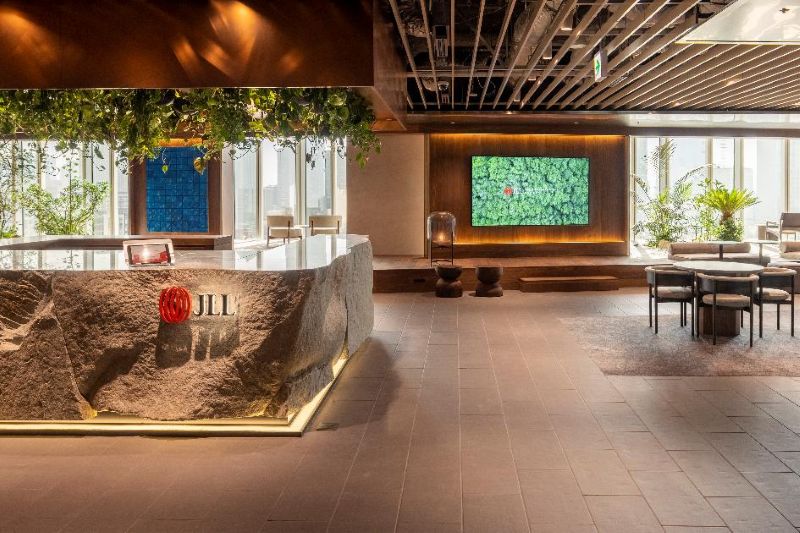
Project Overview
Project Name: JLL Tokyo Office
City: Tokyo
Certification System: LEED v4 ID+C: Commercial Interiors
Certification Date: March 27, 2023
Certification Level: Platinum
Interviewee: Ms. Maki Watanabe, Jones Lang LaSalle K.K.
Interviewer: Shogo Murakami, GBJ Steering Committee
Murakami: JLL’s Tokyo Office has achieved LEED v4 ID+C: Commercial Interiors Platinum certification. Could you share with us the purpose and background behind this achievement?
Watanabe: Let me start with some background to our relocation:
- Our office had become too small due to rapid staff growth.
- Both in Tokyo and Osaka*, we were scattered across three separate offices.
- We needed an upgrade to align with new ways of working and the future vision of our workplace.
At JLL, we are committed to obtaining green building certifications for all offices larger than 10,000 sqft (929 m²) worldwide. By the end of 2023, we had already achieved this goal for 68% of our portfolio.
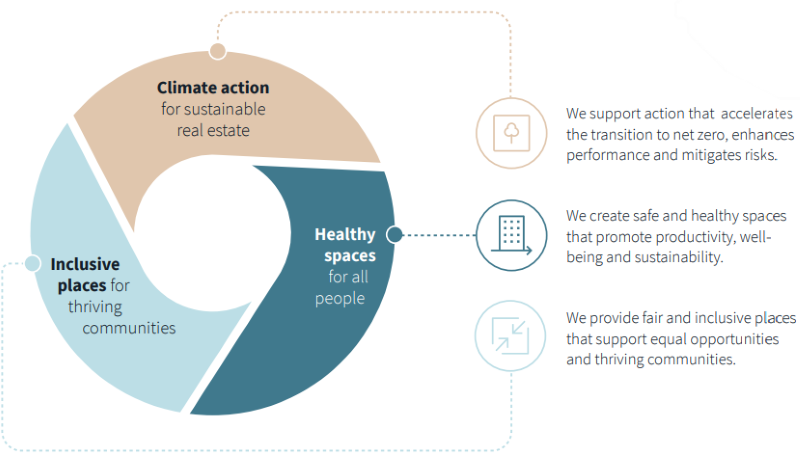
https://www.jll.com/en-jp/about-jll/company-reporting
This image shows that JLL’s Global Sustainability Program focuses on: Climate Action, Healthy Spaces, and Inclusive Places. Together, they form our Sustainability Framework, with each area supported by specific targets.
Major offices worldwide are grouped by scale and other factors, with each group assigned target levels for LEED and WELL certification. For our Tokyo Office, the requirement was Gold or higher in both.
Murakami: At the time of certification, there were only two LEED v4 ID+C Platinum–certified projects in Japan, including the JLL Tokyo Office. Were there any particular initiatives or measures that you undertook?
Watanabe: Yes, JLL’s Tokyo Office achieved Platinum certification under the LEED v4 ID+C: Commercial Interiors rating system, becoming the second project in Japan. For interior projects, a large portion of the total points is influenced by the location and performance of the base building—that is, the building in which the office is leased. Our Energy & Sustainability Services team was involved in the project from the building selection stage, evaluating several potential buildings to determine how many LEED points could be earned.
In central Tokyo, aspects such as development density, public transportation access, and nearby amenities can naturally achieve full points. However, Tokyo Garden Terrace Kioicho stood out in terms of energy efficiency and water-saving performance. Of course, LEED scores were not the only factor in selecting the building, but choosing this property turned out to be an advantage in obtaining the certification.
Another example is the acoustic performance. JLL’s design standard of the sound insulation is exceptionally high, which enabled us to meet the LEED criteria. In addition, carefully managing reverberation, we were able to earn the EQ credit for Acoustic Performance in both Tokyo and Osaka—a credit that has rarely been achieved in Japan. Although there were cost-related challenges, we succeeded in creating a sound environment that greatly enhances user satisfaction.
Murakami: The project is positioned as a workplace that incorporates Activity Based Working (ABW), while continuously enhancing expertise and services. It is defined by five key concepts. Could you briefly introduce each of the concepts?
Watanabe: Of course. The new office is designed for thought leadership – a place to experiment, experience, and enhance the value and services we deliver to clients. It is designed to put our five key concepts into practice, helping us realize our mission: “Shaping the future of real estate for a better world.” These five concepts can be summarized as follows:
New Workstyle & Premium Experience
A high-quality, experiential workplace that puts Activity Based Working (ABW) into practice and reflects JLL’s vision of the “Future of Work.”
Technology & New Discovery
By actively adopting and experimenting with JLL’s latest technologies, we gain insights and discoveries that translate into innovative services for our clients.
Connectivity & Networking
Space that encourages communication and collaboration, strengthening connections and networks among employees, clients, and the wider community.
Wellbeing & Creative Recharge
By improving measurable environmental factors such as light, water, and sound, introducing initiatives that foster a sense of community and engagement among employees, we help boost mental health and motivation. This creates space for physical and mental refreshment, which in turn sparks greater creativity.
Sustainable Thinking
We work on creating a sustainable and environmentally conscious workplace while pursuing LEED and WELL certification. Using visualized data, we continue to evolve the workplace from a long-term perspective.
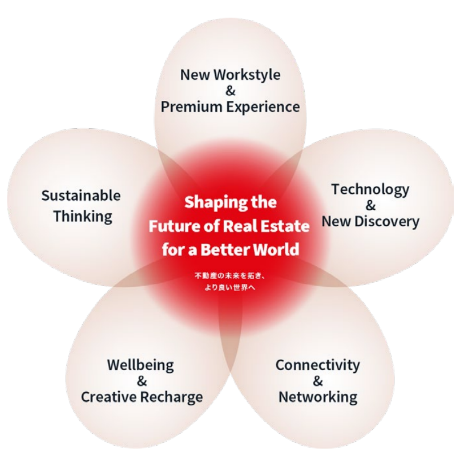
Murakami: The space near the exterior windows, called the “engawa” (veranda), brings a sense of nature even inside the building. How is it being used?
Watanabe: We adopted the following design concepts:
- Creating a pleasant, park-like open space and generous flexibility without limiting usage, where people naturally gather, fostering new discoveries and communication.
- Acquiring the power of natural light and the beauty of “shakkei” (borrowed scenery) through framing, allowing occupants to enjoy the flow of seasons and time While inside of the office.
- Taking advantage of the characteristic of the engawa, a traditional element of Japanese architecture, to control the sunlight and create a pleasant window-side space without the need to lower blinds.
The design is infused with various approaches and innovations that utilize the wisdom of engawa, a traditional Japanese architectural element:
- Ambiguous spaces that coexist with the natural environment according to the four seasons, incorporating nature, connecting inside and outside, where people naturally gather in a relaxed manner.
- Ingenious solutions to control solar radiation and enjoy views without lowering blinds.
- Light that is framed and filtered, allowing enjoyment of natural light penetration, the natural fluctuations of light and shadow, and the passage of time.
- Shakkei that frames landscapes like a picture frame, savoring the beauty of scenery and the changing seasons
- Like cats seeking comfortable places – finding the most pleasant spots.
The area around the engawa is used for various purposes including brief meetings with external clients, meetings between employees, employee breaks, and individual work. In addition to the indoor greenery, the view of the lush grounds of Official Residences of the Speakers of the Diet visible through the windows allows people to constantly refresh themselves while engaging in their various activities.
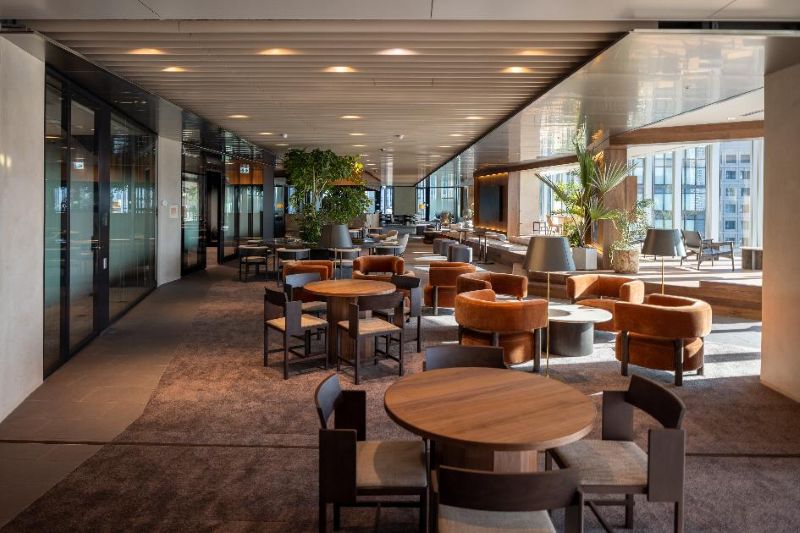
Work Café: an open space where both employees and external guests can gather
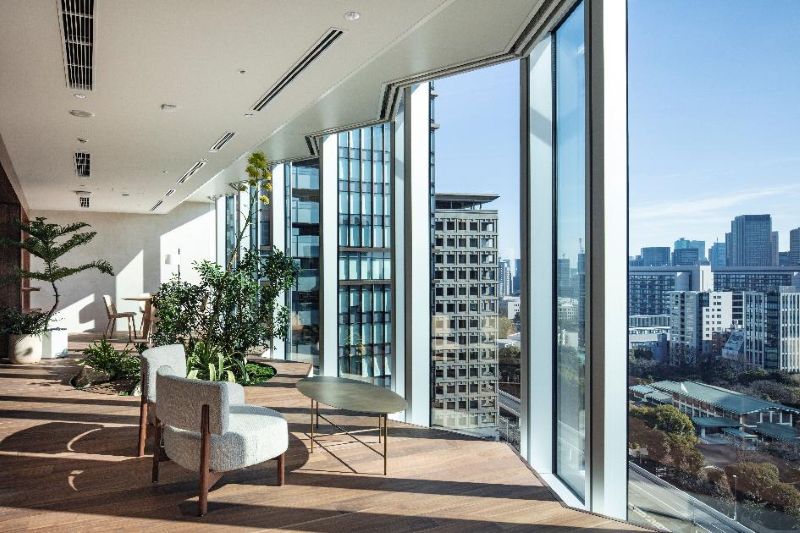
Engawa: a space to enjoy natural light and window-side views
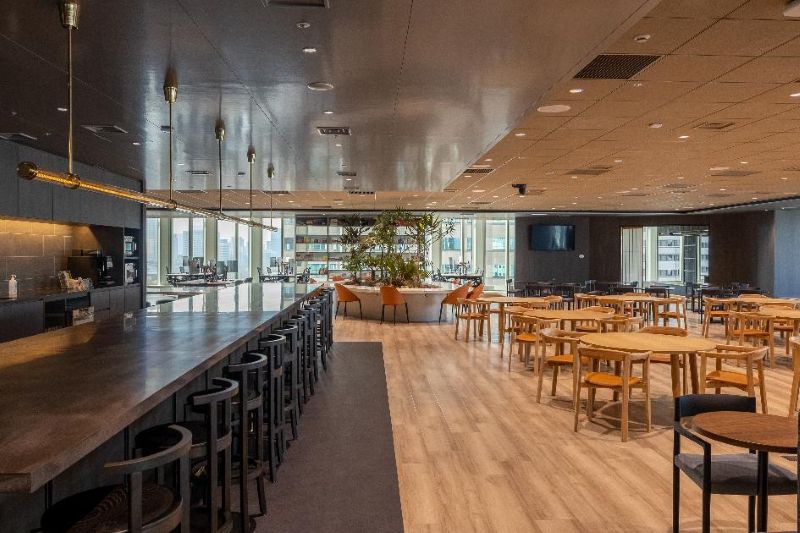
Social Hub: designed to promote collaboration
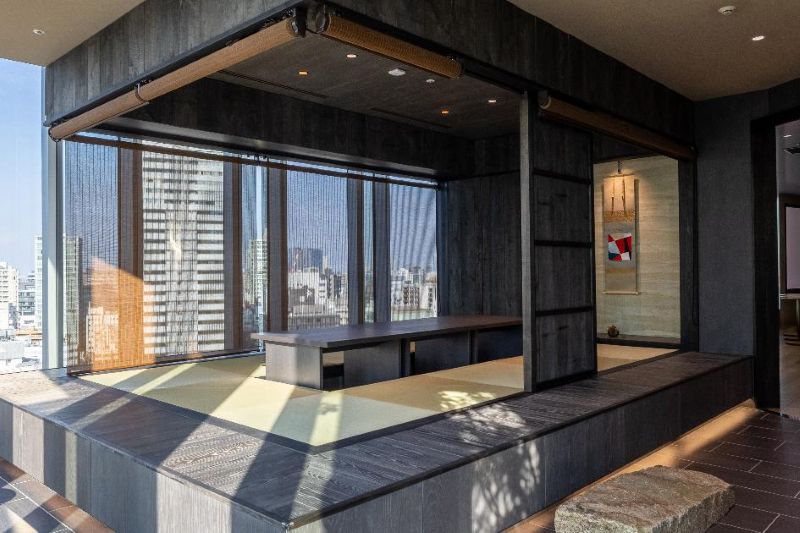
Chaya: a place to work or take a break while experiencing Japanese tradition and culture
Murakami: The latest technology like occupancy density and air quality sensors has been in use for about two years—Have you gained any insights?
Watanabe: From our operations so far, we’ve observed, for example:
- Desk seats equipped with monitors are highly popular and are used for roughly 90% of the working day. However, some desks remain occupied for extended periods without use, so the rule requiring desks to be released if left unattended for more than three hours needs to be enforced more strictly.
- Workstations near plants are used more often.
Murakami: The office includes a variety of spaces that enable activity-based working (ABW). When visitors tour the offices, which spaces tend to attract the most interest? Could you also explain the concept behind these spaces?
Watanabe: Based on visits of our Tokyo and Osaka offices, we have observed that visitors show strong interest in our ABW spaces and design concepts. Please see the two images below for more details.
JLL Tokyo and Osaka Office Evaluations
January 10, 2023 – May 31, 2025; 1,452 respondents out of 4,275 visitors (34% response rate)
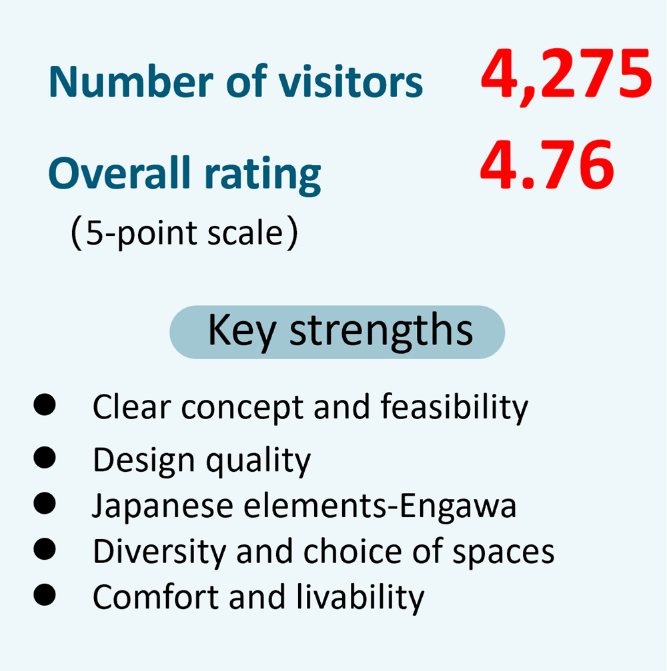
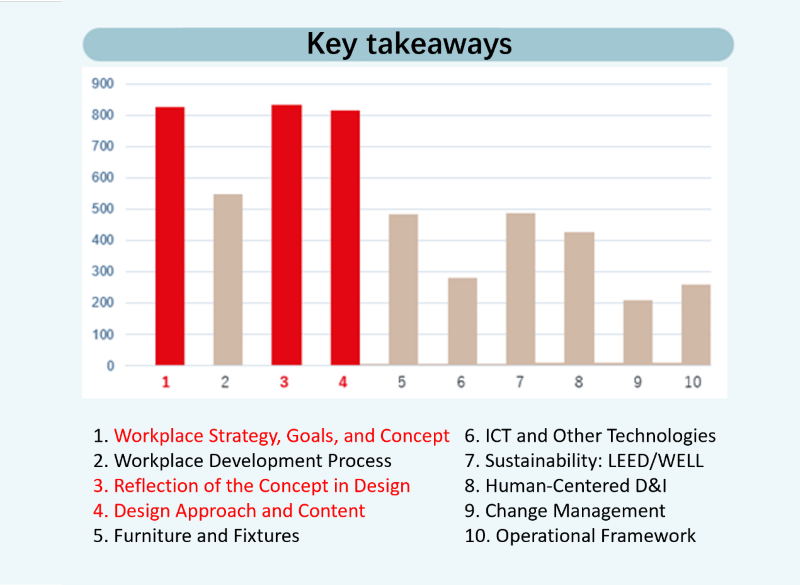
Murakami: Looking at the rapid increase in the number of LEED-certified projects in Japan, it is clear that the demand for “sustainable real estate” is growing. As work styles and lifestyles continue to diversify, what kind of offices do you think will be increasingly required in the future?
Watanabe: Demand is shifting. Previously, ID+C (Interior Design and Construction) projects mainly involved offices for foreign tenants and stores for luxury brands, but recently, projects by Japanese companies have also started to stand out. In March of this year, the Sustainability Standards Board of Japan (SSBJ) published sustainability disclosure standards. These standards will apply from the fiscal year ending March 2027 to companies with a market capitalization of over 3 trillion yen (approximately USD 20 billion), and are expected to extend to all prime-listed companies in the 2030s. We anticipate that third-party environmental certifications will become increasingly important.
Looking ahead, we see rising demand for wellness-focused offices that integrate environmental performance with occupant health and comfort. It is no longer just about energy savings or reducing environmental impact – it is about creating indoor environments that actively promote employee well-being and productivity, including factors such as lighting, air quality, and thermal comfort.
Moreover, office design that supports flexible workstyles is becoming essential. It is important to provide not only assigned desks, but also a variety of workspaces that employees can choose based on their tasks, digital tools that facilitate collaboration with remote workers easy, and shared areas that encourage communication.
In addition, resilient design that balances sustainability with business continuity planning (BCP) is expected to gain importance. Beyond environmental considerations such as renewable energy use, waste reduction, and efficient water management, spaces and facilities that are robust against risks such as natural disasters or infectious disease outbreaks are increasingly valued.
Offices that embody a company’s sustainability strategy and demonstrate social value can also contribute to attracting top talent and enhancing corporate image, making their importance increasingly prominent moving forward.
Murakami: We sincerely appreciate the opportunity to learn about JLL Tokyo Office’s efforts in green building today. Thank you very much for sharing your valuable insights.
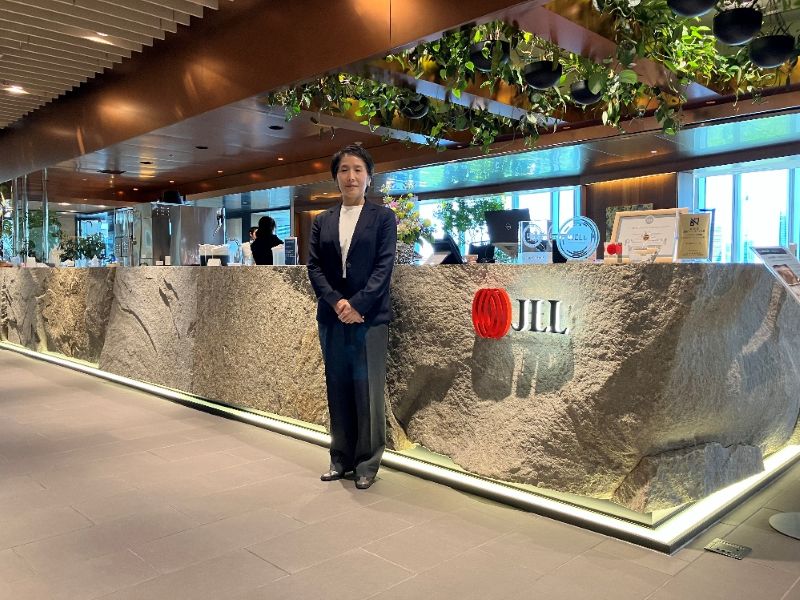
Photo of Ms. Maki Watanabe
Notes
1. *The JLL Osaka Relocation Project was completed concurrently and received Gold certification under the same rating system.
2. The photographs and images in the text are published with the kind permission of Jones Lang LaSalle K.K.
日本語版はこちら


